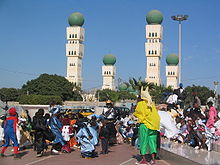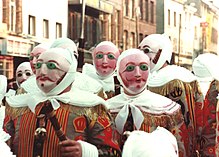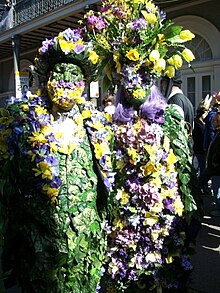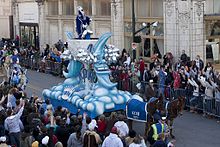Mardi Gras
Submitted by admin on
| Mardi Gras, Carnival | |
|---|---|
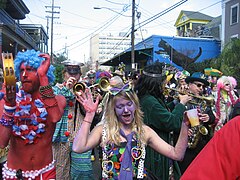
Celebrations in New Orleans, USA
|
|
| Also called | Fat Tuesday, Shrove Tuesday |
| Type | Christian, Cultural |
| Significance | Celebration prior to fasting season of Lent |
| Celebrations | Parades, parties |
| Date | Day before Ash Wednesday, 47 days before Easter |
| 2015 date | February 17 |
| 2016 date | February 9 |
| 2017 date | February 28 |
| Frequency | Annual |
| Related to | Shrove Tuesday; Carnival, Shrove Monday, Ash Wednesday, Lent, Užgavėnės, Maslenitsa, Valentine's Day |
Mardi Gras (/ˈmɑrdiɡrɑː/), also called Shrove Tuesday,[1] or Fat Tuesday,[2][3][4][5][6] in English, refers to events of the Carnival celebrations, beginning on or after the Christian feasts of the Epiphany (Three King's Day) and culminating on the day before Ash Wednesday. Mardi Gras is French for "Fat Tuesday", reflecting the practice of the last night of eating richer, fatty foods before the ritual fasting of the Lenten season.
Related popular practices are associated with celebrations before the fasting and religious obligations associated with the penitential season of Lent. In countries such as England, Mardis Gras is also known as Shrove Tuesday, which is derived from the word shrive, meaning "confess".[1]
Traditions
Popular practices on Mardi Gras include wearing masks and costumes, overturning social conventions, dancing, sports competitions, parades, debauchery, etc. Similar expressions to Mardi Gras appear in other European languages sharing the Christian tradition, as it is associated with the religious requirement for confession before Lent begins. In many areas, the term "Mardi Gras" has come to mean the whole period of activity related to the celebratory events, beyond just the single day. In some American cities, it is now called "Mardi Gras Day".[2][3][4][5][6] It also has become a single people's counter to the coupled-centric Valentine's Day.[6]
The festival season varies from city to city, as some traditions consider Mardi Gras the entire period between Epiphany or Twelfth Night and Ash Wednesday.[7] Others treat the final three-day period before Ash Wednesday as the Mardi Gras.[8] In Mobile, Alabama, Mardi Gras-associated social events begin in November, followed by mystic society balls on Thanksgiving,[7][9] then New Year's Eve, followed by parades and balls in January and February, celebrating up to midnight before Ash Wednesday. In earlier times, parades were held on New Year's Day.[7] Other cities famous for Mardi Gras celebrations include Rio de Janeiro; Barranquilla, Colombia; Port of Spain, Trinidad and Tobago; Quebec City, Canada; Mazatlán and Sinaloa, Mexico; New Orleans, Louisiana; and Mobile, Alabama
Carnival is an important celebration in Anglican and Catholic European nations.[1] In the United Kingdom and Ireland, the week before Ash Wednesday is called "shrovetide", ending on Shrove Tuesday. It has its popular celebratory aspects, as well. Pancakes are a traditional food. Pancakes and related fried breads or pastries made with sugar, fat, and eggs are also traditionally consumed at this time in many parts of Latin America and the Caribbean.
Belgium
In the Belgian city of Binche, the Mardi Gras festival is one of the most important days of the year and the summit of the Carnival of Binche. Around 1000 Gilles dance throughout the city from morning until past dusk, whilst traditional carnival songs play. In 2003, the "Carnival of Binche" was proclaimed one of the Masterpieces of the Oral and Intangible Heritage of Humanity by UNESCO.
Brazil
Carnival is the most famous Brazilian holiday. During this time, Brazil attracts 70% of its tourists. Variations in carnival celebrations are observed throughout the multitude of Brazilian cities. Yet, a commonality observed among them is the incorporation of samba into the celebrations. The southeastern cities of Brazil have massive parades that take place in large sambadromes. The largest carnival celebration in Brazil and the world occurs in Rio de Janeiro, where two million people celebrate in the city. The city of Salvador also holds a large carnival celebration.
Colombia
Carnaval de Barranquilla is Colombia's Mardi Gras celebration. In 2003, it was proclaimed as one of the Masterpieces of the Oral and Intangible Heritage of Humanity by UNESCO.
Germany
The celebration on the same day in Germany knows many different terms, such as Schmutziger Donnerstag or Fetten Donnerstag (Fat Thursday), Unsinniger Donnerstag, Weiberfasching, Greesentag and others, and are often only one part of the whole carnival events during one or even two weeks before Ash Wedensday be called Karneval, Fasching, or Fastnacht among others, depending on the region. In Standard German, schmutzig means "dirty", but in the Alemannic dialects schmotzig means "lard" (Schmalz), or "fat";[10] "Greasy Thursday", as remaining winter stores of lard and butter used to be consumed at that time, before the fasting began. Fastnacht means "Eve of the Fast", but all three terms cover the whole carnival season. The traditional start of the carnival season is on November 11 at 11:11am (11/11 11:11).
Italy
In Italy Mardi Gras is called Martedí Grasso (Fat Tuesday). It's the main day of Carnival along with the Thursday before, called Giovedí Grasso (Fat Thursday), which ratifies the start of the celebrations. The most famous Carnivals in Italy are in Venice, Viareggio and Ivrea. Ivrea has the characteristic "Battle of Oranges" that finds its roots in medieval times. Italy is the birthplace of Carnival celebrations, having its origins in the ancient Roman festival of Saturnalia. The Italian version of the festival is spelled Carnevale.[11]
Netherlands
The Netherlands also has a festival similar to Mardi Gras. It's called Carnaval and is similar to the Venice Carnival. The origin of the word Carnaval is 'carnem levare' which means "to take away meat" in Latin. It marks the beginning of lent leading up to Easter.
The carnival in the Netherlands is mainly held in the southern part of the Netherlands in the provinces of Noord-Brabant and Limburg, some parts of Zeeland and in eastern parts of Twente and Gelderland. As with many popular festivals, people tend to loosen some moral codes and become laid-back or loose, which is based in the ancient role-reversal origins of Carnaval, including dressing in costumes.
Sweden
In Sweden the celebration is called Fastan, when you eat fastlagsbulle, also called Fettisdagsbulle . That name comes from the words "fett" (fat) and "tisdag" (Tuesday). Originally, this was the only day one should eat fastlagsbullar.[12]
United States
While not observed nationally throughout the United States, a number of traditionally ethnic French cities and regions in the country have notable celebrations. Mardi Gras arrived in North America as a French Catholic tradition with the Le Moyne brothers,[13] Pierre Le Moyne d'Iberville and Jean-Baptiste Le Moyne de Bienville, in the late 17th century, when King Louis XIV sent the pair to defend France's claim on the territory of Louisiane, which included what are now the U.S. states of Alabama, Mississippi, Louisiana and part of eastern Texas.[13]
The expedition, led by Iberville, entered the mouth of the Mississippi River on the evening of March 2, 1699, Lundi Gras. They did not yet know it was the river explored and claimed for France by René-Robert Cavelier, Sieur de La Salle in 1683. The party proceeded upstream to a place on the east bank about 60 miles downriver from where New Orleans is today, and made camp. This was on March 3, 1699, Mardi Gras, so in honor of this holiday, Iberville named the spot Point du Mardi Gras (French: "Mardi Gras Point") and called the nearby tributary Bayou Mardi Gras. Bienville went on to found the settlement of Mobile, Alabama in 1702 as the first capital of French Louisiana.[14] In 1703 French settlers in Mobile established the first organized Mardi Gras celebration tradition in what was to become the United States.[13][15][16][17] The first informal mystic society, or krewe, was formed in Mobile in 1711, the Boeuf Gras Society.[15] By 1720, Biloxi had been made capital of Louisiana. The French Mardi Gras customs had accompanied the colonists who settled there.[13]
In 1723, the capital of Louisiana was moved to New Orleans, founded in 1718.[14] The first Mardi Gras parade held in New Orleans is recorded to have taken place in 1837. The tradition in New Orleans expanded to the point that it became synonymous with the city in popular perception, and embraced by residents of New Orleans beyond those of French or Catholic heritage. Mardi Gras celebrations are part of the basis of the slogan, Laissez les bons temps rouler, (Let the good times roll).[13][not in citation given] Other cities along the Gulf Coast with early French colonial heritage, from Pensacola, Florida; Galveston, Texas; to Lafayette, Louisiana; and north to Natchez, Mississippi, have active Mardi Gras celebrations in balls. In the rural Acadiana area, many Cajuns celebrate with the Courir de Mardi Gras, a tradition that dates to medieval celebrations in France.[18] The American rock band Creedence Clearwater Revival created a project in 1972 called Mardi Gras
See also
References
- ^ Jump up to: a b c Melitta Weiss Adamson, Francine Segan (2008). Entertaining from Ancient Rome to the Super Bowl. ABC-CLIO. In Anglican countries, Mardis Gras is known as Shrove Tuesday-from shrive meaning "confess"-or Pancake Day"-after the breakfast food that symbolizes one final hearty meal of eggs, butter, and sugar before the fast. On Ash Wednesday, the morning after Mardi Gras, repentant Christians return to church to receive upon the forehead the sign of the cross in ashes.
- ^ Jump up to: a b In London, Mardi Gras season: "Paul's Pastry Shop kneads a ton of dough in Picayune", Allbusiness.com, 2009, webpage: Allbusiness-35.
- ^ Jump up to: a b In New Orleans, Mardi Gras season: "Mardi Gras in New Orleans | Metro.co.uk", Metro.co.uk, 2009, webpage; Metro.co.uk-2315.
- ^ Jump up to: a b In Mobile, Mardi Gras season: "New Orleans has competition for Mardi Gras", USATODAY.com, February 2006, webpage: USATODAY-com-mardi.
- ^ Jump up to: a b In San Diego, Mardi Gras season: "sandiego.com - Mardi Gras in San Diego: FAQ's", SanDiego.com, 2008, webpage: SanDiego.com-SD.
- ^ Jump up to: a b c In Texas, Mardi Gras season: "Let’s Celebrate: Mardi Gras 2008", Southernbyways.com, January 2008, webpage: southernbyways-com-TX.
- ^ Jump up to: a b c "Mardi Gras Terminology". "Mobile Bay Convention & Visitors Bureau". Retrieved November 18, 2007.
- Jump up ^ "The Season of Lent". Crivoice.org. January 7, 2010. Retrieved October 16, 2010.
- Jump up ^ "Mobile Carnival Association, 1927", MardiGrasDigest.com, 2006, webpage: mardigrasdigest-Mobile.
- Jump up ^ "Woher hat der Schmutzige Donnerstag seinen Namen?". Regionalzeitung Rontaler AG (in German). 17 February 2013. Retrieved 2015-02-07.
- Jump up ^ "History of Carnival". All Ah We. Retrieved October 3, 2012.
- Jump up ^ "Swedish semla: more than just a bun". Sweden.se. Retrieved February 22, 2011.
- ^ Jump up to: a b c d e "New Orleans & Mardi Gras History Timeline " (event list), Mardi Gras Digest, 2005, webpage: MG-time.[dead link]
- ^ Jump up to: a b "Timeline 18th Century:" (events), Timelines of History, 2007, webpage: TLine-1700-1724: on "1702-1711" of Mobile.
- ^ Jump up to: a b "Carnival/Mobile Mardi Gras Timeline". Museum of Mobile. Museum of Mobile. Retrieved July 18, 2012.
- Jump up ^ "Mardi Gras in Mobile" (history), Jeff Sessions, Senator, Library of Congress, 2006, webpage: LibCongress-2665.
- Jump up ^ "Mardi Gras" (history), Mobile Bay Convention & Visitors Bureau, 2007, webpage: MGmobile.
- Jump up ^ "Mardi Gras in Rural Acadiana". Retrieved February 18, 2010.
External links
| Wikimedia Commons has media related to Mardi Gras. |
- Traditional Cajun Mardi Gras Celebrations
- Mardi Gras in Mobile, Encyclopedia of Alabama
- Prof. Carl Nivale's Compleat Carnival Compendium and Mardi Gras Manual
- Mardi Gras 2014 celebration photos
- Mardi Gras 2009 celebration photos
- Where to Celebrate Mardi Gras Around the World - slideshow by The Guardian
- Fashion plates featuring historic Mardi Gras costumes from the Metropolitan Museum of Art Libraries
